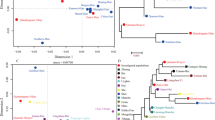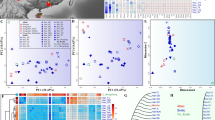Abstract
We performed a molecular characterization of Korean Y-chromosomal haplogroups using a combination of Y-chromosomal single nucleotide polymorphisms (Y-SNPs) and Y-chromosomal short tandem repeats (Y-STRs). In a test using DNA samples from 706 Korean males, a total of 19 different haplogroups were identified by 26 Y-SNPs including the newly redefined markers (PK4, KL2, and P164) in haplogroup O. When genotyping the SNPs, phylogenetic nonequivalence was found between SNPs M117 and M133, which define haplogroup O3a3c1 (O3a2c1a according to the updated tree of haplogroup O by Yan et al. (European Journal of Human Genetics 19:1013–1015, 2011)), suggesting that the position of the M133 marker should be corrected. We have shown that the haplotypes consisted of DYS392, DYS393, DYS437, DYS438, DYS448, and DYS388 loci, which exhibit a relatively lower mutation rate, can preserve phylogenetic information and hence can be used to roughly distinguish Y-chromosome haplogroups, whereas more rapidly mutating Y-STRs such as DYS449 and DYS458 are useful for differentiating male lineages. However, at the relatively rapidly mutating DYS447, DYS449, DYS458, and DYS464 loci, unusually short alleles and intermediate alleles with common sequence structures are informative for elucidating the substructure within the context of a particular haplogroup. In addition, some deletion mutations in the DYS385 flanking region and the null allele at DYS448 were associated with a single haplogroup background. These high-resolution haplogroup and haplotype data will improve our understanding of regional Y-chromosome variation or recent migration routes and will also help to infer haplogroup background or common ancestry.




Similar content being viewed by others
References
Jobling MA, Pandya A, Tyler-Smith C (1997) The Y chromosome in forensic analysis and paternity testing. Int J Legal Med 110:118–124
Jobling MA, Tyler-Smith C (2000) New uses for new haplotypes the human Y chromosome, disease and selection. Trends Genet 16:356–362
Jobling MA (2001) In the name of the father: surnames and genetics. Trends Genet 17:353–357
Underhill PA, Shen P, Lin AA et al (2000) Y chromosome sequence variation and the history of human populations. Nat Genet 26:358–361
Jobling MA, Tyler-Smith C (2003) The human Y chromosome: an evolutionary marker comes of age. Nat Rev Genet 4:598–612
Roewer L, Croucher PJ, Willuweit S et al (2005) Signature of recent historical events in the European Y-chromosomal STR haplotype distribution. Hum Genet 116:279–291
Roewer L, Kayser M, Dieltjes P, Nagy M, Bakker E, Krawczak M, de Knijff P (1997) Analysis of molecular variance (AMOVA) of Y-chromosome-specific microsatellites in two closely related populations. Hum Mol Genet 5:1029–1033
Butler JM (2003) Recent developments in Y-short tandem repeat and Y-single nucleotide polymorphism analysis. Forensic Sci Rev 15:91–111
Jobling MA (2001) Y-chromosomal SNP haplotype diversity in forensic analysis. Forensic Sci Int 118:158–162
Bosch E, Calafell F, Santos FR et al (1999) Variation in short tandem repeats is deeply structured by genetic background on the human Y chromosome. Am J Hum Genet 65:1623–1638
Schlecht J, Kaplan ME, Barnard K, Karafet T, Hammer MF, Merchant NC (2008) Machine-learning approaches for classifying haplogroup from Y chromosome STR data. PLoS Comput Biol 4:e1000093
Athey TW (2005) Haplogroup prediction from Y-STR values using an allele-frequency approach. J Genet Geneal 1:1–7
Kayser M, Brauer S, Weiss G, Schiefenhövel W, Underhill PA, Stoneking M (2001) Independent histories of human Y chromosomes from Melanesia and Australia. Am J Hum Genet 68:173–190
Myres NM, Ekins JE, Lin AA, Cavalli-Sforza LL, Woodward SR, Underhill PA (2007) Y-chromosome short tandem repeat DYS458.2 non-consensus alleles occur independently in both binary haplogroups J1-M267 and R1b3-M405. Croat Med J 48:450–459
Myres NM, Ritchie KH, Lin AA, Hughes RH, Woodward SR, Underhill PA (2009) Y-chromosome short tandem repeat intermediate variant alleles DYS392.2, DYS449.2, and DYS385.2 delineate new phylogenetic substructure in human Y-chromosome haplogroup tree. Croat Med J 50:239–349
Robino C, Crobu F, Di Gaetano C et al (2008) Analysis of Y-chromosomal SNP haplogroups and STR haplotypes in an Algerian population sample. Int J Legal Med 122:251–255
Willuweit S, Roewer L, International Forensic Y Chromosome User Group (2007) Y chromosome haplotype reference database (YHRD): update. Forensic Sci Int Genet 1:83–87
Onofri V, Alessandrini F, Turchi C, Fraternale B, Buscemi L, Pesaresi M, Tagliabracci A (2007) Y-chromosome genetic structure in sub-Apennine populations of Central Italy by SNP and STR analysis. Int J Legal Med 121:234–237
Nonaka I, Minaguchi K, Takezaki N (2007) Y-chromosomal binary haplogroups in the Japanese population and their relationship to 16 Y-STR polymorphisms. Ann Hum Genet 71:480–495
Kim SH, Han MS, Kim W, Kim W (2010) Y chromosome homogeneity in the Korean population. Int J Legal Med 124:653–657
Karafet TM, Mendez FL, Meilerman MB, Underhill PA, Zegura SL, Hammer MF (2008) New binary polymorphisms reshape and increase resolution of the human Y chromosomal haplogroup tree. Genome Res 18:830–838
Yan S, Wang CC, Li H, Li SL, Jin L, Genographic Consortium (2011) An updated tree of Y-chromosome Haplogroup O and revised phylogenetic positions of mutations P164 and PK4. Eur J Hum Genet 19:1013–1015
Kim SH, Kim KC, Shin DJ et al (2011) High frequencies of Y-chromosome haplogroup O2b-SRY465 lineages in Korea: a genetic perspective on the peopling of Korea. Investig Genet 2:10
Park MJ, Lee HY, Yoo JE, Chung U, Lee SY, Shin KJ (2005) Forensic evaluation and haplotypes of 19 Y-chromosomal STR loci in Koreans. Forensic Sci Int 152:133–147
Lee HY, Park MJ, Chung U, Lee HY, Yang WI, Cho SH, Shin KJ (2007) Haplotypes and mutation analysis of 22 Y-chromosomal STRs in Korean father-son pairs. Int J Legal Med 121:128–135
Park MJ, Lee HY, Kim NY, Sim JE, Yang WI, Cho SH, Shin KJ (2007) Genetic characteristics of 22 Y-STR loci in Koreans. Korean J Leg Med 31:162–170
Park MJ, Shin KJ, Kim NY, Yang WI, Cho SH, Lee HY (2008) Characterization of deletions in the DYS385 flanking region and null alleles associated with AZFc microdeletions in Koreans. J Forensic Sci 53:331–334
Excoffier L, Lischer HEL (2010) Arlequin suite ver 3.5: a new series of programs to perform population genetics analyses under Linux and Windows. Mol Ecol Resour 10:564–567
Gomes V, Sánchez-Diz P, Amorim A, Carracedo A, Gusmão L (2010) Digging deeper into East African human Y chromosome lineages. Hum Genet 127:603–613
Parson W, Roewer L (2010) Publication of population data of linearly inherited DNA markers in the International Journal of Legal Medicine. Int J Legal Med 124:505–509
Balaresque P, Bowden GR, Parkin EJ et al (2008) Dynamic nature of the proximal AZFc region of the human Y chromosome: multiple independent deletion and duplication events revealed by microsatellite analysis. Hum Mutat 29:1171–1180
Karafet TM, Hallmark B, Cox MP, Sudoyo H, Downey S, Lansing JS, Hammer MF (2010) Major east-west division underlies Y chromosome stratification across Indonesia. Mol Biol Evol 27:1833–1844
Gusmão L, Krawczak M, Sánchez-Diz P et al (2003) Bimodal allele frequency distribution at Y-STR loci DYS392 and DYS438: no evidence for a deviation from the stepwise mutation model. Int J Legal Med 117:287–290
Ballantyne KN, Keerl V, Wollstein A et al (2012) A new future of forensic Y-chromosome analysis: rapidly mutating Y-STRs for differentiating male relatives and paternal lineages. Forensic Sci Int Genet 6:208–218
Cinnioğlu C, King R, Kivisild T et al (2004) Excavating Y-chromosome haplotype strata in Anatolia. Hum Genet 114:127–148
Shi H, Dong YL, Wen B et al (2005) Y-chromosome evidence of southern origin of the East Asian-specific haplogroup O3-M122. Am J Hum Genet 77:408–419
Acknowledgments
The authors would like to thank the anonymous reviewers for their valuable comments and suggestions on our paper.
This research was supported by Future-based Technology Development Program through the National Research Foundation of Korea (NRF) funded by the Ministry of Education, Science and Technology (No. 2010-0020631).
Author information
Authors and Affiliations
Corresponding author
Rights and permissions
About this article
Cite this article
Park, M.J., Lee, H.Y., Yang, W.I. et al. Understanding the Y chromosome variation in Korea—relevance of combined haplogroup and haplotype analyses. Int J Legal Med 126, 589–599 (2012). https://doi.org/10.1007/s00414-012-0703-9
Received:
Accepted:
Published:
Issue Date:
DOI: https://doi.org/10.1007/s00414-012-0703-9




